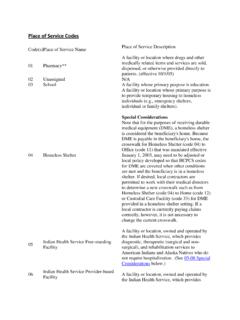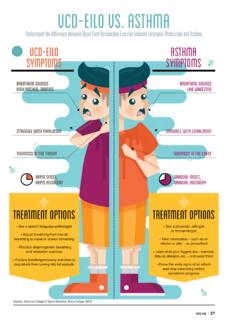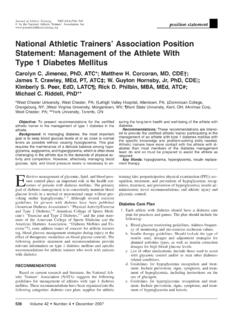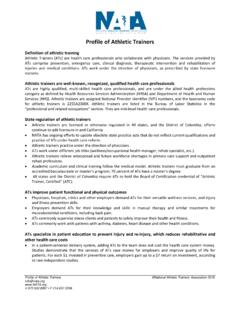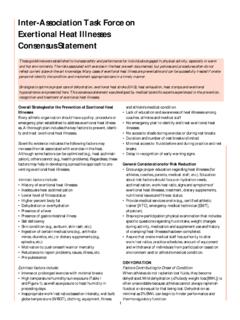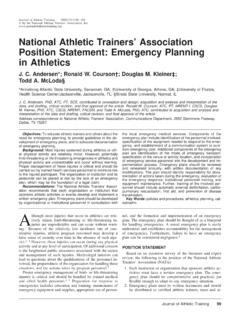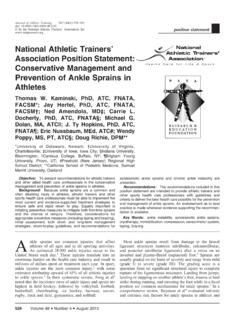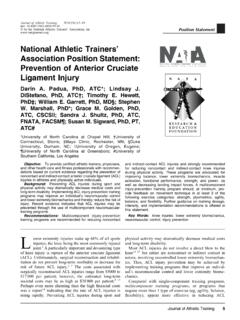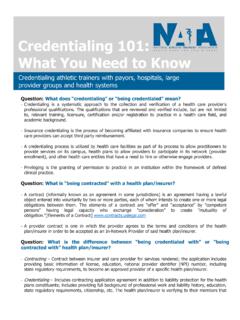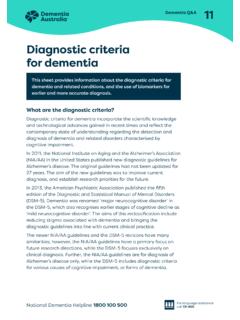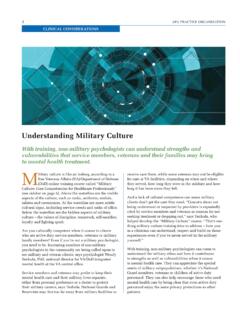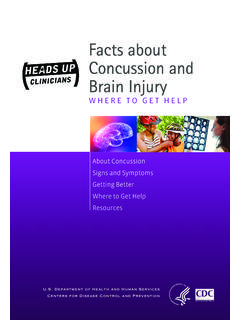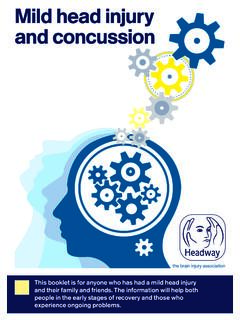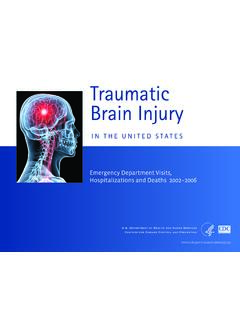Transcription of National Athletic Trainers’ Association Position Statement ...
1 Journal of Athletic Training2014;49(2):245 265doi: by the National Athletic Trainers Association , statementNational Athletic Trainers Association Position Statement :Management of ,PhD,ATC*; , MD ; Gerard A. Gioia, PhD ; Kevin , PhD, ATC, FNATA, FACSM ;Jeffrey Kutcher, MD*; Michael Palm, MBA,ATC||; Tamara C. Valovich McLeod, PhD, ATC,FNATA *University of Michigan, Ann Arbor; Department of Surgery,Emerson Hospital, Concord, MA; Division of PediatricNeuropsychology, Children s National Medical Center, Washington,DC; Department of Exercise and Sport Science, University of NorthCarolina, Chapel Hill; ||Athletico Physical Therapy, Oak Brook, IL; Athletic Training Program, Still University, Mesa, AZObjective:To provide Athletic trainers, physicians, andother health care professionals with best-practice guidelines forthe management of sport-related :An estimated million concussions occureach year in the United States as a result of sport and physicalactivity. Athletic trainers are commonly the first medicalproviders available onsite to identify and evaluate these :The recommendations for concussionmanagement provided here are based on the most currentresearch and divided into sections on education and prevention,documentation and legal aspects, evaluation and return to play,and other Words: mild traumatic brain injuries, pediatric concus-sions, education, assessment, evaluation, documentationDespite a significant increase in research dedicatedto identifying and managing sport-related concus-sion, it remains one of the most complex injuriessports medicine professionals face.
2 Concussions occur fromforces applied directly or indirectly to the skull that result inthe rapid acceleration and deceleration of the brain . Thesudden change in cerebralvelocity elicits neuronalshearing, which produces changes in ionic accompanied by clinical signs andsymptoms, changes at the cellular level are commonlyreferred to asmild traumatic brain injury , or occur in males and females of all ages and inall sports, but are most common in contact and collisionactivities. Data collected from emergency department visitsshow a 62% increase (153 375 to 248 418) in nonfataltraumatic brain injuries between 2001 and 2009,3with asmany as million reported and unreported sport- andrecreation-related concussions occurring each year in theUnited licensed medical professionals, Athletic trainers (ATs)receive comprehensive didactic and clinical training inconcussion management. They are typically the firstproviders to identify and evaluate injured persons and areintegral in the postinjury management and return-to-play(RTP) decision-making process.
3 Without exception, ATsshould be present at all organized sporting events at alllevels of play and should work closely with a physician ordesignate who has specific training and experience inconcussion management to develop and implement aconcussion-management plan based on the recommenda-tions outlined update to the initial 2004 National Athletic Trainers Association Position Statement on the management ofsport-related concussion,5this document contains recom-mendations on concussion management for practicing ATsbased on the most recent scientific evidence. A review ofthe literature supporting these recommendations has alsobeen included. The document covers the topics of Education and Prevention, Documentation and LegalAspects, Evaluation and RTP, and Other Consider-ations. Journal of Athletic Training245 injury DEFINITIONTo best assemble the available concussion research andremain consistent with other medical groups, we sought toevaluate literature that definedconcussionas a trauma-induced alteration in mental status that may or may notinvolve loss of consciousness.
4 6 This definition wasselected based on its broad application by medicalorganizations and widespread use within the literaturefrom the time of the first National Athletic Trainers Association Position Statement . We recognize the strengthof the definition provided by the International Concussionin Sport Group and its subpoints as valid features thatfurther define evaluating and writing thisdocument, we also included research defining concussiveinjuries in these terms. Notably absent from the literatureand consistent with previous recommendations were theterms ding, getting one s bell rung, clearing thecobwebs, and other such phrases in reference toconcussive colloquial terms are antiquat-ed, minimize injury severity, and should not be used torefer to concussion or mild traumatic brain FOR CLINICAL PRACTICEE ducation and PreventionThe clinical practice recommendations for each topichave been graded based on the Strength of Recommenda-tion Taxonomy (SORT; Table 1).81. The AT should use, and educate others in using, theproper terminology of concussion and mild traumaticbrain injury as opposed to such colloquial terms as ding and bell ringer.
5 9 Strength of Recommendation: B2. TheATshouldworkwiththeappropriate administratorsto ensure that parents and coaches are educated on thefollowing aspects of concussion: prevention, mechanism,recognition and referral, appropriate return to participa-tion, physical and cognitiverestrictions for concussedathletes, and ramifications of improper 12 Strength of Recommendation: B3. The AT should be aware of and document potentialmodifying factors that could delay the RTP, and patientsshould be educated on the implications of these conditionsas they affect recovery (Table 2).7 Strength of Recom-mendation: C4. The AT should work to educate coaches, athletes, andparents about the limitations of protective equipment forconcussion of Recommendation: C5. As part of educational efforts, ATs, athletes, coaches, andparents should read all warning labels associated withprotective of Recommendation: CDocumentation and Legal Aspects6. The AT should be aware of any and all relevant governingbodies (eg, state, Athletic conference) and their policiesand procedures regarding concussion of Recommendation: C7.
6 The AT should document the athlete s (and whenappropriate, the parent s) understanding of concussivesigns and symptoms and his or her responsibility to reporta of Recommendation: C8. The AT should communicate the status of concussedathletes to the managing physician on a regular of Recommendation: C9. The AT should ensure proper documentation of theconcussion evaluation, management, treatment, return-to-Table 1. Strength of Recommendation Taxonomy (SORT)aStrength ofRecommendationsDefinitionARecommendati on based on consistent and good quality experimental evidence (morbidity, mortality, exercise andcognitive performance, physiologic responses)BRecommendation based on inconsistent or limited quality experimental evidenceCRecommendation based on consensus; usual practice; opinion; disease-oriented evidenceb; case series or studies ofdiagnosis, treatment, prevention, or screening; or extrapolations from quasi-experimental researchaReprinted with permission from Strength of Recommendation Taxonomy (SORT): A Patient-Centered Approach to Grading Evidence inthe Medical Literature, February 1, 2004, American Family Physician.
7 Copyright 2004 American Academy of Family Physicians. AllRights evidence measures outcomes that matter to patients: morbidity, mortality, symptoms improvement, cost reduction, andquality of life. Disease-oriented evidence measures are intermediate, physiologic, or surrogate end points that may or may not reflectimprovements in patient outcomes (eg, blood pressure, blood chemistry, physiologic function, pathologic findings).Table 2. Factors That May Modify the Risk of Concussion andDuration of Recovery7 RiskModifiersSymptomsNumberDuration (.10 d)SeveritySignsProlonged loss of consciousness (.1 min),amnesiaSequelaeConcussive convulsionsTemporalFrequency: repeated concussions over timeTime: injuries close together in timeRecency: recent concussion or traumatic braininjuryThresholdRepeated concussions occurring withprogressively less impact, force, or slowerrecovery after each successive eventAgeChild or adolescent (,18 y)Comorbidities andpremorbiditiesMigraine, depressions, or other mental healthdisorders; attention-deficit hyperactivity disorder;learning disabilities; sleep disordersMedicationPsychoactive drugs, anticoagulantsBehaviorDangerous style of playSportHigh-risk activity, contact or collision sport, highsporting level246 Volume 49 Number 2 April 2014participation progression, and physician of Recommendation: CEvaluation and RTP10.
8 Athletes at high risk of concussion (eg, those in contact orcollision sports) should undergo baseline examinationsbefore the competitive ,13,14 Strength of Recom-mendation: B11. A new baseline examination should be completedannually for adolescent athletes, those with a recentconcussion, and, when feasible, all 17 Strengthof Recommendation: B12. The baseline examination should consist of a clinicalhistory (including any symptoms), physical and neuro-logic evaluations, measures of motor control (eg,balance), and neurocognitive ,7,18 20 Strength ofRecommendation: B13. The baseline and postinjury examinations should beadministered in similar environments that maximize thepatient s abilities, and all baseline examinations should bereviewed for suboptimal ofRecommendation: C14. Any athlete suspected of sustaining a concussion shouldbe immediately removed from participation and evaluatedby a physician or designate (eg, AT).Strength ofRecommendation: C15. The concussion diagnosis is made through the clinicalevaluation and supported by assessment Recommendation: B16.
9 When the rapid assessment of concussion is necessary (eg,during competition), a brief concussion-evaluation tool(eg, Standardized Assessment of Concussion[SAC]20,22,23) should be used in conjunction with amotor-control evaluation and symptom assessment tosupport the physical and neurologic clinical of Recommendation: B17. Once a concussion diagnosis has been made, the patientshould undergo a daily focused examination to monitorthe course of of Recommendation: C18. During the acute postconcussion recovery stage, dailytesting of neurocognitive function and motor control istypically not needed until the patient is of Recommendation: C19. A concussed athlete should not be returned to athleticparticipation on the day of of Recom-mendation: C20. No concussed athlete should return to physical activitywithout being evaluated and cleared by a physician ordesignate (eg, AT) specifically trained and experienced inconcussion evaluation and ofRecommendation: C21. Young athletes with a past medical history that includesmultiple concussions, a developmental disorder (eg,learning disabilities, attention-deficit hyperactivity disor-der), or a psychiatric disorder (eg, anxiety, depression)may benefit from referral to a neuropsychologist toadminister and interpret neurocognitive assessments anddetermine readiness to return to scholastic and ,25 Strength of Recommendation: C22.
10 A physical-exertion progression should begin only afterthe concussed athlete demonstrates a normal clinicalexamination, the resolution of concussion-related symp-toms, and a return to preinjury scores on tests of motorcontrol and neurocognitive ,26 Strength ofRecommendation: C23. Concussed athletes who do not show a typical progressivereturn to normal functioning after injury may benefit fromother treatments or of Recommenda-tion: C24. Concussion-grading scales should not be used to managethe injury . Instead, each patient should be evaluated andtreated on an individual ,9 Strength of Recommen-dation: B25. After the injury has resolved, the concussion may beretrospectively graded for the purpose of medical of Recommendation: COther The AT should enforce the standard use of certifiedhelmets while educating athletes, coaches, and parentsthat although such helmets help to prevent catastrophichead injuries (eg, skull fractures), they do not signifi-cantly reduce the risk of ,27 29 Strength ofRecommendation: B27.
